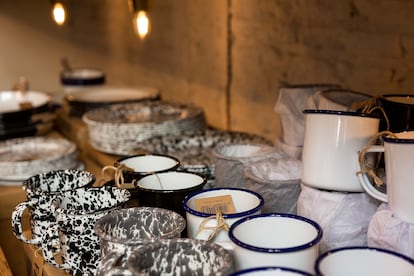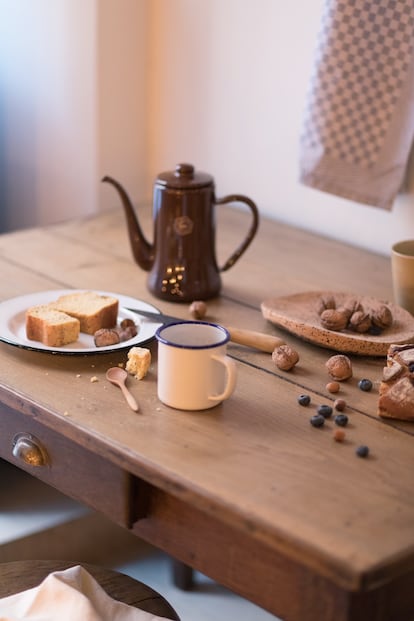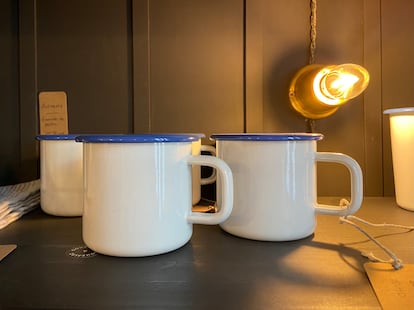‘Vintage,’ rural, and irresistibly simple: why we’re obsessed with steel mugs
Glazed dinnerware with blue rims once graced the kitchens of endearing pre-Instagram families. Today, pewterware is the zeitgeist, appreciated for its functionality, sustainability and touch of nostalgia

“I remember when my brothers and I used to set the table at my grandmother’s house as children, placing amber Duralex plates on the checkered tablecloth,” says Carlos Lopez, professor of art history and restoration specialist. That weekly ritual — which momentarily interrupted watching that week’s episode of The Knights of the Zodiac with a cacophonous transfer of pots and pans between the dining room and the kitchen — subliminally molded an entire generation’s relationship with everyday objects. In many cases, the link with that mealtime paraphernalia was broken, leaving no more than a happy, now somewhat hazy memory, as we moved from Dick and Jane to the Superman comics. In others, as happened to this art historian, it was the trigger for an unconditional affection for the most modest domestic design. Because the beauty of the everyday is not in things, but above all in the way we look at them and the way we relate to them.
The mug that more than one generation used for their after-school chocolate milk is enjoying an explosive resurgence. It is sober, humble, minimalist, discreet, and irresistibly simple. Made of stainless steel enameled with baked glass powder the mugs are bright chalk white with a rim that is painted blue. Today, their main virtue is not their durability, their unbreakability, or how hygienic they are — there are cutting-edge technological materials that surpass these qualities. They are not microwave safe and the enamel chips off. But there is something that makes these mugs desirable, and that is their ability to evoke the most intimate memories. Because just like silence or slowness, nostalgia is a virtue that is on the rise.
Back to the future

Falcon Enamelware, a firm that has been equipping British home life since 1920, is Europe’s pioneering manufacturer of pewterware, as this glazed ceramic is also known. For over a century, it has been producing an assorted catalog of kitchenware: glasses, plates, saucepans, bowls, cups and pie dishes in its factory near the city of Birmingham. In the eighties, the Gipuzcoa-based brand Ibili (website in Spanish) launched a line of enameled steel tableware produced in its factory at Bergara in the Basque region of Spain. Versatility is one of the great attributes that the Basque firm highlights of its White line, available in practically any hardware store in Spain. “It has a vintage, rural feel, but it also knows how to dress up at the tables of the most sophisticated restaurants in the cities,” Ibili says.
Recently, the increase in tariffs due to Brexit has favored the entry of new European suppliers on the scene, such as the German Münder-Email (website in German), with a more eclectic showcase (they have soap dishes, funnels, skimmers, butter dishes, egg cups, candlesticks, garden accessories …. The list goes on). The European competitors have taken over part of the import market that used to be monopolized by the illustrious and increasingly expensive British pewterware.
In the kitchen, the dining room, the bathroom, on the terrace, for camping or picnics, sitting out in the garden, by the sea or at the table of many a cheap-and-cheerful restaurant, pewterware has gone from being part of the family’s modest everyday routine to claiming its place as one of the omnipresent materials of the moment. The generation of nostalgic 40-somethings embrace it. Their children too.
The charm of authenticity

Why is it that the unbreakable cup that we used for our chocolate milk and the bowl with an unmistakable sound that our grandmother used to beat eggs are so popular today? Firstly, because they are well thought out. “Domestic objects speak of rituals, of time, of the everyday. When their design is based on experience, functionality, and ergonomics, it will last for a long time,” explains Barbara Pierpaoli, professor of History of Furniture Design and Decoration at the Istituto Europeo di Design (IED). Like the tempered glass tableware from Duralex, the Moulinex yogurt maker with its little pots, the translucent opaline coffee sets from Arcopal, the porcelain from Bidasoa or the anodized aluminum jugs from Manufacturas Metálicas Madrileñas, I find the white enameled steel pieces with blue rims mentally comforting because they bring a timeless, everyday aesthetic to my home,” says Carlos López. The art historian is also a seasoned treasure hunter of vintage pieces from the early 20th century.
“Today the concept of design is related not only to appearance or performance, but also to values,” Pierpaoli argues. A well designed object makes sense when it is useful and when it satisfies the performance of a function without losing sight of human and environmental well-being. With its minimalist and timeless lines, the humble pewterware is a benchmark of functionality and elegance. “It speaks to us of simplicity, an asset rising in value that connects with the idea of sustainability. Because good design is that which meets a need, and at the same time, respects the environment. Good design must be social and environmental,” adds the IED professor. This mug was conceived with practical criteria, above all, to be useful in everyday domestic life. In its gestation there was no artistic vocation, and yet today it is a piece with an aesthetic and even anthropological value that deserves to be part of the culture of design in its own right.
Intergenerational crush

The pursuit of sustainability through making thoughtful decisions, such as avoiding plastic at all costs, has led many young people in their early twenties to instantly connect with the century-old pewterware. Enameled steel belongs to the past, the present and the future. It is more than an aesthetic design: it is also an ethical choice. But, undoubtedly, the element that best explains this connection is nostalgia. “The nostalgia of those who, suddenly, when entering our store, come across that dish their grandmother used to beat eggs, or the pan they used to heat the milk for their coffee at their house in the village,” says Maria Rosa Amor, founder of the everyday objects project Casa Gonzalez & Gonzalez. The affection that regular customers of this charming grocery store in the Salesas district of Madrid have for the pewterware that takes them back to their childhood is sincere, instinctive. “My grandmother had a dish just like that one in her kitchen,” is something that has been heard at Casa González & González more than once.
“Have nothing in your home that has no use or that you don’t think is beautiful,” proclaimed William Morris, multi-faceted craftsman and father of the Arts and Crafts movement. In the last 60 years, the phenomenon of mass consumerism has sadly moved us against Morris’ sensible approach. In addition, this has led to an excessive use of natural resources and generating waste that is difficult to recycle. That’s why a mug designed a century ago, that can last forever, and looks more desirable than ever can convey so much. So, raise your pewterware mugs in a toast to pragmatism, elegance, conceptual intelligence, love for nature and respect for a job well done.
Sign up for our weekly newsletter to get more English-language news coverage from EL PAÍS USA Edition
Tu suscripción se está usando en otro dispositivo
¿Quieres añadir otro usuario a tu suscripción?
Si continúas leyendo en este dispositivo, no se podrá leer en el otro.
FlechaTu suscripción se está usando en otro dispositivo y solo puedes acceder a EL PAÍS desde un dispositivo a la vez.
Si quieres compartir tu cuenta, cambia tu suscripción a la modalidad Premium, así podrás añadir otro usuario. Cada uno accederá con su propia cuenta de email, lo que os permitirá personalizar vuestra experiencia en EL PAÍS.
¿Tienes una suscripción de empresa? Accede aquí para contratar más cuentas.
En el caso de no saber quién está usando tu cuenta, te recomendamos cambiar tu contraseña aquí.
Si decides continuar compartiendo tu cuenta, este mensaje se mostrará en tu dispositivo y en el de la otra persona que está usando tu cuenta de forma indefinida, afectando a tu experiencia de lectura. Puedes consultar aquí los términos y condiciones de la suscripción digital.
More information
Últimas noticias
Most viewed
- Sinaloa Cartel war is taking its toll on Los Chapitos
- Oona Chaplin: ‘I told James Cameron that I was living in a treehouse and starting a permaculture project with a friend’
- Reinhard Genzel, Nobel laureate in physics: ‘One-minute videos will never give you the truth’
- Why the price of coffee has skyrocketed: from Brazilian plantations to specialty coffee houses
- Silver prices are going crazy: This is what’s fueling the rally










































